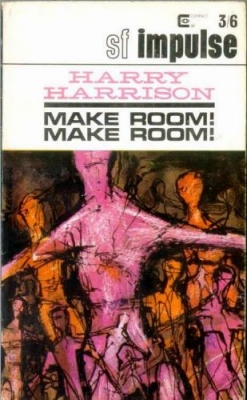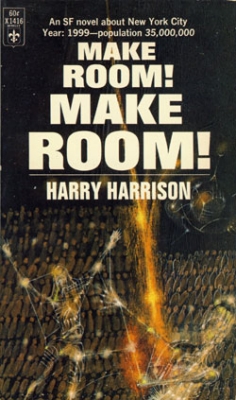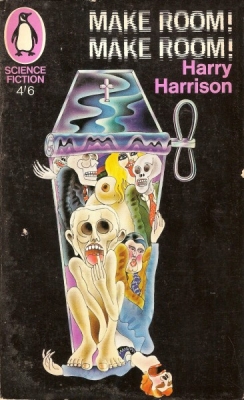The Golden Age of Science Fiction: Make Room! Make Room!, by Harry Harrison
An award called The Prix Jules Verne would seem to be presented in France, and, in fact, such a literary prize was given out in France from 1927 to 1933 and 1958 to 1963 for fantasy and science fiction by French authors. However, the Prix Jules Verne that was presented from 1975 to 1980 was a Swedish award about which little is known. The first one was given to Roland Adlerberth. Rolf Ahlgren, Eugen Semitjov, and Lars-Olov Strandberg for their service to Swedish science fiction. Subsequent awards were presented to individual authors for specific novels. The first novel to win the award was Ursula K. Le Guin’s The Left Hand of Darkness. The last award before it was discontinued was presented to Harry Harrison for Make Room! Make Room!.
Make Room! Make Room! is best known for being the inspiration for the 1973 Charlton Heston and Edward G. Robinson film Soylent Green, although there are significant differences between the film and the novel. The novel is an interesting and atypical work. While the protagonist, Andy Rusch, is a police detective tasked with tracking down the murderer of Big Mike O’Brien and discovering if there are political implications in Big Mike’s death, it is not a police procedural and the crime and investigation often take a back seat. Harrison also provides the identity of the killer, as well as telling parts of the story from his point of view, throughout the book.
The novel also looks at the budding relationship between Rusch and Shirl, who had been living with O’Brien until his death and has now transferred her affection to Rusch. However, their relationship is also not a focus of the novel, neither is Rusch’s friendship with Sol, his elderly flatmate who provides him with occasional words of wisdom and just as often rambling commentary.
The real focus of the novel is on the overpopulation of New York in 1999, with 35 million people living in the city (it was actually only 8 million) and the scarcity of food and water providing for that many people occasioned. Food and water riots are common occurrences and in his role as a detective, Rusch is frequently called upon to keep control. His constant need to be working is the biggest threat to his budding relationship with Shirl. Despite the many threads in the novel, it also reads as a slice of life story, providing glimpses into the characters’ lives without any real overarching theme to the story beside the horrors created by overpopulation and scarce resources.
In the novel, soylent, a mixture of soybean and lentil, is referred to occasionally as one of the meat replacements created to feed an ever-growing population, along with weedcrackers, made from seaweed. Unlike the film, these food products serve to underscore the way humanity has been overusing the earth’s resources. They form a very small part of the overall story, which mostly focuses on how Rusch and Shirl manage to live their daily lives in a crowded New York where water and food are rationed and expensive.
While Harrison includes some scenes which clearly show how overcrowded New York is, with rioting occurring throughout the city, food and water lines, and people living in abandoned cars left in parking lots throughout the city, Harrison mostly hints at the complexity of the situation in New York. Characters like Big Mike and Judge Santini show that there are political forces at work in the city which do not impact the major characters in an obvious manner in their day-to-day lives, although Big Mike’s death causes concerns to those powers that will have major repercussions for Rusch, as will his eventual solution to their problems. Harrison provides the feeling that his characters are moving through a much larger world than simply the people with whom they interact, even if the streets of New York don’t always feel crowded.
Other nominees for the Prix Jules Verne are not known.
 Steven H Silver is a sixteen-time Hugo Award nominee and was the publisher of the Hugo-nominated fanzine Argentus as well as the editor and publisher of ISFiC Press for 8 years. He has also edited books for DAW, NESFA Press, and ZNB. He began publishing short fiction in 2008 and his most recently published story is “Webinar: Web Sites” in The Tangled Web. His most recent anthology, Alternate Peace was published in June. Steven has chaired the first Midwest Construction, Windycon three times, and the SFWA Nebula Conference 6 times, as well as serving as the Event Coordinator for SFWA. He was programming chair for Chicon 2000 and Vice Chair of Chicon 7.
Steven H Silver is a sixteen-time Hugo Award nominee and was the publisher of the Hugo-nominated fanzine Argentus as well as the editor and publisher of ISFiC Press for 8 years. He has also edited books for DAW, NESFA Press, and ZNB. He began publishing short fiction in 2008 and his most recently published story is “Webinar: Web Sites” in The Tangled Web. His most recent anthology, Alternate Peace was published in June. Steven has chaired the first Midwest Construction, Windycon three times, and the SFWA Nebula Conference 6 times, as well as serving as the Event Coordinator for SFWA. He was programming chair for Chicon 2000 and Vice Chair of Chicon 7.


